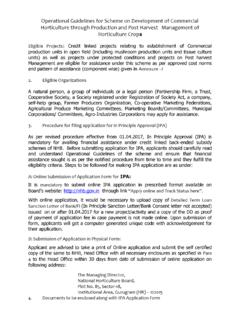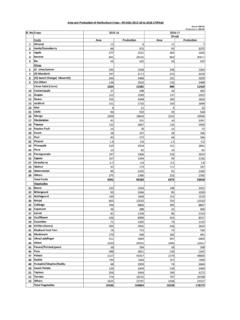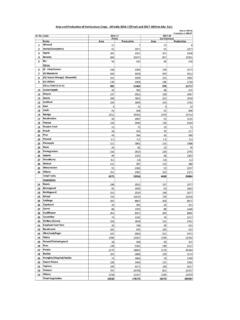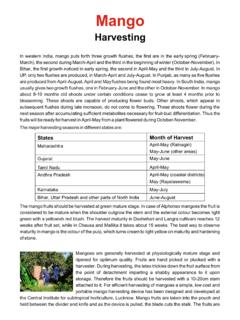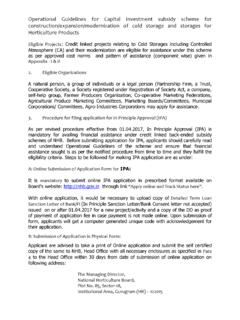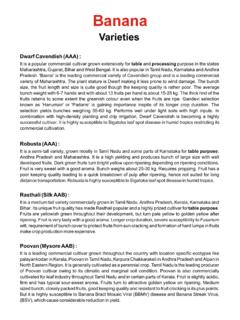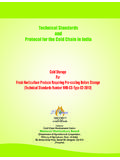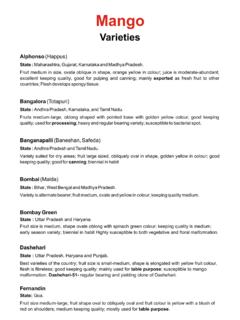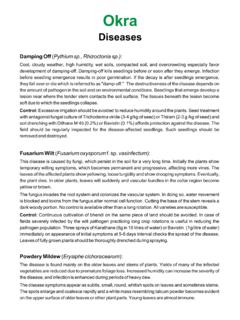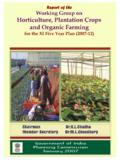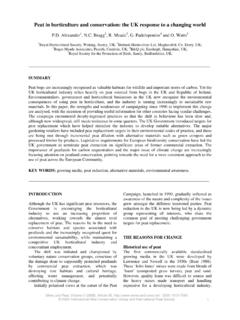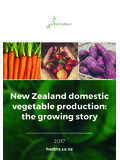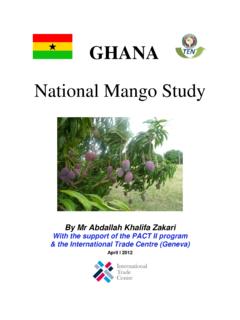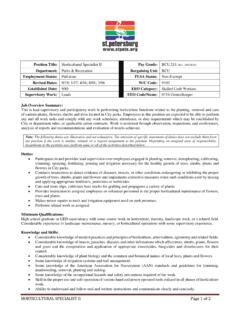Transcription of FINAL FILE NEW SIZE - NHB
1 Ih-ds- feJ] ih ,p Mh] Hkkjr ljdkj vkbZ , ,l f"k ea=ky;. lfpo] Hkkjr ljdkj f"k ,oa lgdkfjrk foHkkx Mishra, PhD Government of India IAS Hkkjr ljdkj Ministry of Agriculture Secretary Department of Agriculture & Cooperation Government of India PREFACE. Availability of quality planting material is a prerequisite to the success of horticulture development initiatives. The Working Group on horticulture and Plantation Crops for the Eleventh Five Year Plan has projected the total requirement of planting materials of fruits, coconut, cashew, black paper, tree spices, areca-nut etc. as 2000 million by the year 2012 at a modest growth rate of 4% per annum. In the segment of fruit crops alone, the projected demand for the planting material would be 7,145,851 by the year 2007-08; which may increase to 8,359,632 by the year 2011-12. Supply of such a huge quantity of disease free, true to type quality planting material is a big challenge and needs to be addressed at the right time.
2 The Seeds Act and the Nursery Registration Act have been in operation since December 1966. However, as reported by the said Working Group, the Nursery Registration Act is presently in force in respect of horticulture nurseries only in the States of Punjab, Maharashtra, Himachal Pradesh, Uttar Pradesh, Uttrakhand, Jammu and Kashmir, Orissa and Tamil Nadu. Some system of registering/. monitoring exists for horticulture nurseries in the States of Andhra Pradesh, Assam, Bihar, Goa, Haryana, Karnataka, Kerala while there is no horticulture nursery act in the States of Arunachal Pradesh, Chattisgarh, Jharkhand, Madhya Pradesh, Manipur, Meghalaya, Mizoram, Nagaland, Rajasthan, Sikkim, Tripura and West Bengal. In the absence of any formal system of quality assurance for horticulture planting material, it is not feasible to put any kind of quality control related restrictions on horticulture nurseries which do not have adequate production-related infrastructure and pedigreed mother plants.
3 With a view to ensuring availability of genuine and quality planting material until a new regime of registration of horticulture nurseries under the provisions of a new Seeds Act come in force, it is essential to put a system of Recognition of horticulture Nurseries in place to facilitate, promote and monitor production and trade of quality planting materials of horticulture crops with a special emphasis on perennial fruit crops which are propagated vegetatively. It is heartening to note that the National horticulture Board under the Ministry of Agriculture has taken initiative to start a voluntary system of recognition of horticulture Nursery which is a system of graded certification of production system and procedure in respect of a candidate horticulture nursery. It is different from the system of Licensing of horticulture Nurseries under provisions of an Act or 1. Administrative Orders and is aimed at establishing a network of quality horticulture nurseries across the country for the purpose of propagation and distribution of quality planting material of horticulture crops.
4 Guidelines for Recognition of horticulture Nursery have been prepared by the National horticulture Board in consultation with the Department of Agriculture and Cooperation and the ICAR; which, in turn, not only provide for a procedure of nursery recognition but also aim at capacity building among owners of horticulture nurseries to continuously strive for upgrading the same to attain a higher level of recognition and maintain the quality so as to meet the criterion of regular surveillance too. I hope that this system of Recognition of horticulture Nursery by the NHB will fill the existing systemic gap in ensuring supply of quality planting material and go a long way establishing a network of quality horticulture nurseries across the country. ( Mishra). New Delhi 17th July 2008. Office: Krishi Bhawan, New Delhi - 110001, nwjHkk"k@Phone: 23382651, 23388444. QSDl ua-@Fax No.: 23386004. E-mail: 2. INTRODUCTION. Inadequate availability of quality planting material is one of the important deterring factors in development of sound horticulture industry.
5 It is of special significance especially in perennial horticultural crops which has a long gestation period and effects are known only in later stages. In the existing infrastructure, there are just over 100 big nurseries. A number of Government nurseries also exist in different states. Planting material is also being produced by the ICAR institutes and SAUs, Private nurseries also play important role to meet the requirement of the growers and at present the number of small and medium scale nurseries is over 6300. Presently only 30-40%. demand of planting material is being met by the existing infrastructure . Generally, Farmers do not have access to good quality certified disease free planting material of true to type varieties as a result of which production, productivity and quality of the of produce suffers heavily. At present, most of the dependence is on the unregulated private sector nurseries in most of the states which lacks modern infrastructure such as green house, mist chamber, efficient nursery tools and gadgets, implements and machinery.
6 There are several constraints in the existing system of plant propagation. There are several private nurseries operating in the country playing important role in multiplication of planting material of horticulture crops and many of them follow traditional methods and lack adequate infrastructure and sell plant material of unknown pedigree. Of many other constraints, un-availability of standardized root stocks and non- maintenance of healthy stocks of elite varieties are worth mentioning. Working group on horticulture and Plantation crops for the XI Five Year has projected the total requirement of planting material of fruits , coconut, cashew, black pepper, tree spices. areca-nut etc. as 2000 distribution of quality planting material of horticulture crops. Guidelines prepared by National horticulture Board for Recognition of horticulture Nursery not only provides information for procedure of recognition but also provide technical information for setting up of fruit plant nursery.
7 It is hoped that this system will fill up the existing gap and go a long way to establish a network of quality horticulture nurseries across the country. Bijay Kumar Managing Director NHB. 3. 4 Our Quality P. Quality lanting M. Planting aterial is our P. Material Prroper ty We car operty e. care. Guidelines for Recognition of horticulture Nursery BACKGROUND. Availability of true to type, quality planting material is crucial for success of commercial horticulture . This necessitates having a net-work of horticulture Nurseries which conform to Model Nursery Standards in terms of Infrastructure, Quality of Seed and Planting Materials and adoption of Nursery Management Practices. State Governments ensure supply of quality planting materials for fruit crops by enactment of Fruit Plant Nursery (Regulation) Act and enforcement of its provisions through licensing of horticulture nurseries. However, all the States have not enacted horticulture Nursery Acts.
8 As per the information available in report of the working group on horticulture for the XI Five Year Plan, at present only 8 states have adopted Nursery Act and in 9 states some system of registration/ monitoring exists for nurseries whereas in 13 states there is no nursery act at present. Status of adoption of Nursery Act is given at Annexure I. Further, rules framed under existing acts generally do not provide for Technical Specification for Quality of Planting Material and Process of Production, Infrastructure required for production of quality planting material and Good Nursery Management Practices. The Acts in present form also do not deal with planting materials of flowers, ornamental plants, plants and vegetables. Therefore, it has become necessary to find a solution to the problem by putting in place a system of Recognition of horticulture Nurseries. National horticulture Mission has taken initiative to specify the Nursery Standards by specifying Infrastructure required for setting up of Model horticulture Nursery etc.
9 ICAR. has recently come out with technical specification of horticulture planting material and its production procedure in a recently published document titled as Handbook of seed and planting material testing manual for Horticultural crops . Existing Rules framed under horticulture Nursery (Regulation) Acts provide for record keeping part for such nurseries. However, each one of them individually does not completely define a Model horticulture Nursery. Therefore, it is imperative to define a Model Nursery in all the three aspects of Nursery Infrastructure, Production System & Quality Parameters of Planting Material and Good Nursery Management Practices in a comprehensive manner and put a Nursery Our Quality P. Quality lanting M. Planting aterial is our P. Material Prroper ty We car operty e. care. 5. Recognition Regime in place. A recognized Model horticulture Nursery should function as a reliable source of supply of quality planting material for horticulture crops.
10 With a view to ensure availability of Good Quality planting material as outlined above, NHB has started a system of Recognition of horticulture Nurseries on voluntary basis. SCOPE. The scope of the scheme is to establish a network of quality nurseries across the country for the purpose of propagation and distribution of quality planting material of specified horticulture crops. The recognition shall be accorded to the nurseries for: a) Production of quality planting material of one or more specified crops by adopting Good Nursery management Practices, b) Nursery Premise only where sale of specified quality planting material of recognized source are being carried out by creating necessary infrastructure facilities and proper record keeping. Note: If different premises are being used for nursery, recognition of all these are required to be obtained separately and individually. The recognition shall be accorded to the nurseries for the crops specified in the Document of recognition Recognition shall be granted as such or after up gradation as per requirement.
